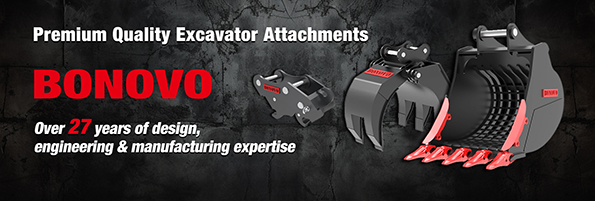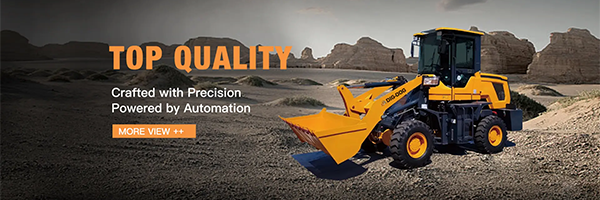In today's diversified engineering construction field, from construction to resource recycling, from mining operations to environmental protection projects, the demand for material screening is growing. "12-18 ton excavators" play an important role in many engineering projects due to their moderate operating capacity and good maneuverability. The "rotary screening bucket" that matches it has become a key accessory to improve operating efficiency and expand the functions of the excavator. Next, we will take a closer look at this rotary screening bucket for 12-18 ton excavators.
In-depth analysis of the working principle
The core working mechanism of the rotary screening bucket revolves around its unique drum device. When it is installed on the "12-18 ton excavator", it is powered by the hydraulic system of the excavator. Specifically, the cylinder is closely connected to the drum device, and the hydraulic motor drives the drum device to rotate at high speed around its own axis. When the material to be screened enters the drum device, the material is constantly flipped and rolled on the screen surface under the combined action of the centrifugal force and gravity generated by the high-speed rotation of the drum. Among them, qualified materials with smaller particle sizes (i.e., under-screen products) will be discharged smoothly through the specially designed discharge port at the bottom of the rear end of the drum during this process; while unqualified materials with larger particle sizes (over-screen products) will be discharged from the discharge port at the tail of the drum. It is worth mentioning that due to the continuous flipping and rolling of the materials in the drum, those materials that may be stuck in the sieve holes will be effectively ejected. This feature greatly prevents the occurrence of sieve hole blockage and ensures that the screening work can be carried out continuously and efficiently. For example, when screening mixed sand and gravel in a sand and gravel field, smaller sand will pass through the sieve holes to become under-screen products, while larger stones will be discharged from the discharge port, achieving accurate separation of sand and gravel.
Significant advantages of adapting to 12-18 ton excavators
Powerful power matching
The 12-18 ton excavator itself has a stable and powerful power output, and its hydraulic system can provide sufficient and suitable power for the rotating screening bucket. This enables the screening bucket to maintain stable screening performance when facing various complex materials, such as hard ores and highly sticky soil. Compared with the situation of insufficient power and low screening efficiency that may occur when some small excavators are equipped with screening buckets, the combination of 12-18 ton excavators and rotary screening buckets can easily cope with large-scale, high-intensity screening tasks, greatly improving the material handling volume per unit time.
Excellent mobility and flexibility
12-18 ton excavators have good mobility in engineering sites, and they can flexibly shuttle between different operating areas. When the rotary screening bucket is installed, this mobility advantage is continued. Whether it is in a narrow urban construction site where construction waste needs to be screened, or in a vast mining site where ore is graded and screened, it can quickly reach the operating position and flexibly adjust the operating angle and position according to the actual working conditions. Compared with large fixed screening equipment, it does not require a complicated installation and debugging process, nor is it restricted by the fixed location of the site. It truly enables screening operations to be carried out anytime and anywhere, bringing great convenience to engineering construction.
Precise operation control
The excavator operator can precisely control the rotary screening bucket through the familiar excavator control system. During the operation, the pressure and flow of the hydraulic system can be precisely adjusted according to the characteristics of the material and the screening requirements, so as to achieve flexible adjustment of parameters such as the drum speed and the impact force. For example, when dealing with materials with smaller particles and softer texture, the drum speed can be appropriately reduced to avoid unnecessary damage to the material caused by excessive screening; when facing materials with larger particles and higher hardness, the drum speed and the impact force are increased to ensure the screening effect. This precise operation control not only improves the screening quality, but also reduces the equipment loss caused by improper operation.
Wide range of application scenarios
Construction field
During the construction process, a large amount of construction waste will be generated, such as discarded concrete blocks, bricks, wood, metal, etc. "12-18 ton excavator rotary screening bucket" can effectively screen and classify these construction wastes. By screening out materials of different particle sizes, they can be recycled, such as gravel and sand that meet the requirements for new concrete mixing, and wood and metal for recycling and reprocessing. This not only reduces the pollution of construction waste to the environment, but also reduces the procurement cost of building materials and realizes the recycling of resources. In addition, in the construction of building foundations, screening the soil in the site to remove debris and large particles can provide better basic conditions for subsequent foundation treatment.
Mining industry
In mining operations, ore classification and screening is an important link. The rotary screening bucket can perform preliminary screening on the mined raw ore and separate ore of different particle sizes for more targeted processing in the future. For some small mines or areas with more complex mining conditions, 12-18 ton excavators with rotary screening buckets can flexibly operate inside the mine, avoiding the inconvenience of transportation and installation of large screening equipment. For example, in some small limestone mines, the ore is classified according to particle size by screening buckets and sent to different processing production lines, which improves the overall efficiency and economic benefits of mining.
Environmental protection and resource recycling field
With the continuous improvement of environmental awareness, resource recycling has become more and more important. In urban waste treatment plants, rotary screening buckets can screen mixed garbage, separate recyclable materials such as plastics, paper, and metals, and collect them for recycling; at the same time, non-recyclable garbage can be further classified for reasonable landfill or incineration. In river cleaning projects, 12-18 ton excavator rotary screening buckets can be used to screen the silt and gravel at the bottom of the river, and useful sand and stone resources can be screened out for use in construction or other engineering fields, while cleaning the river and improving the river's ecological environment.
Installation and maintenance points
Installation process
Preparation: Before installing the rotary screening bucket, first make sure that the "12-18 ton excavator" is in good working condition. Check whether the hydraulic system of the excavator is normal and whether there is any leakage; confirm whether the excavator's working device, such as the boom, dipper and other structural parts, are strong and not deformed or damaged. At the same time, prepare the tools required for installation, such as wrenches, screwdrivers, cranes, etc., and prepare the corresponding installation accessories, such as pins, bolts, nuts, seals, etc., according to the installation instructions of the screening bucket. In addition, a comprehensive appearance inspection of the rotary screening bucket is required to check whether there is any damage caused during transportation. Only after ensuring that the equipment is intact can it be installed.
Installation steps: Use a crane to slowly lift the rotary screening bucket and bring it close to the connection part of the excavator. Adjust the position of the screening bucket so that the connection holes on the bucket are accurately aligned with the corresponding installation holes on the excavator boom and dipper rod. After aligning the hole position, apply an appropriate amount of grease to the pre-prepared pin shaft, and then insert it into the connection hole to make the screening bucket and the excavator preliminarily connected. Then, use bolts and nuts to lock the pin shaft. When tightening the bolts, operate according to the specified torque value to ensure that the connection is firm and reliable. After the connection is completed, connect the hydraulic pipeline of the excavator to the hydraulic interface of the rotary screening bucket. Pay attention to the connection sequence and sealing performance of the pipeline to prevent hydraulic oil leakage. After connecting the hydraulic pipeline, check again whether all the connection parts are firm and whether the hydraulic pipeline is connected correctly. After confirming that there is no error, start the excavator and conduct a no-load test run to check whether the installation of the rotary screening bucket is stable and whether all components are working properly.
Maintenance
Daily inspection: Daily inspection should be carried out before using the rotary screening bucket every day. The inspection content includes whether the appearance of the screening bucket is damaged, whether the connection parts are loose, whether the hydraulic pipeline is leaking, etc. Pay special attention to check whether the screen is damaged or blocked. If there is a problem with the screen, it should be repaired or replaced in time. At the same time, check whether the rotation of the roller device is flexible, whether there is a jam, and the lubrication of each lubrication point, and replenish grease in time. In addition, the hydraulic oil level and oil temperature of the excavator should be checked to ensure that the hydraulic system can work properly. Through daily inspection, problems with the equipment can be discovered in time to avoid failures during work and affect the progress of the project.
Regular maintenance: Regular maintenance is essential for the long-term and stable operation of the rotary screening bucket. Generally speaking, the screening bucket needs to be maintained every certain working time or working hours. Maintenance includes replacing hydraulic oil, cleaning hydraulic filters, checking the wear of various components and performing necessary repairs or replacements. When replacing hydraulic oil, choose high-quality hydraulic oil that meets the requirements of the equipment and replace it according to the prescribed method to ensure the cleanliness and normal operation of the hydraulic system. Cleaning the hydraulic filter can prevent impurities from entering the hydraulic system and damaging the hydraulic components of the equipment. For the wearing parts of the screening bucket, such as screens, pins, bearings, etc., their degree of wear should be checked regularly. When the wear reaches a certain degree, they should be replaced in time to ensure the performance and reliability of the equipment. At the same time, the overall structure of the equipment should also be checked, such as whether there are cracks or deformations in the welding parts. If there are any problems, they should be repaired in time. Through regular maintenance, the service life of the rotary screening bucket can be extended, its working performance can be improved, and the failure rate of the equipment can be reduced.
The rotary screening bucket for 12-18 ton excavators has become an indispensable screening equipment in the field of engineering construction due to its unique working principle, good compatibility with excavators, wide application scenarios, and relatively simple installation and maintenance. It not only improves operating efficiency and reduces costs, but also makes positive contributions to resource recovery and environmental protection. Whether in large-scale engineering projects or small-scale operation scenarios, it can play a huge role and provide strong support for the efficient development of engineering construction.
Rotary Screening Bucket for 12-18 Ton Excavators
- BONOVO
- Counselor
- Posts: 645
- Joined: Oct 17th, '24, 02:50
- Location: China
Rotary Screening Bucket for 12-18 Ton Excavators
Choose BONOVO for high-quality, customizable brush cutters for skid steers with fast delivery. Contact us today to discover how our superior products can enhance your land management tasks!
for more info just visit our website at www.bonovogroup.com
contact # : +86 158 6218 2088
email : sales@bonovogroup.com
for more info just visit our website at www.bonovogroup.com
contact # : +86 158 6218 2088
email : sales@bonovogroup.com

